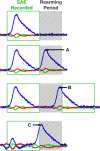When to Pull the Trigger: Conceptual Considerations for Approximating Head Acceleration Events Using Instrumented Mouthguards
- PMID: 38460080
- PMCID: PMC11239719
- DOI: 10.1007/s40279-024-02012-5
When to Pull the Trigger: Conceptual Considerations for Approximating Head Acceleration Events Using Instrumented Mouthguards
Abstract
Head acceleration events (HAEs) are acceleration responses of the head following external short-duration collisions. The potential risk of brain injury from a single high-magnitude HAE or repeated occurrences makes them a significant concern in sport. Instrumented mouthguards (iMGs) can approximate HAEs. The distinction between sensor acceleration events, the iMG datum for approximating HAEs and HAEs themselves, which have been defined as the in vivo event, is made to highlight limitations of approximating HAEs using iMGs. This article explores the technical limitations of iMGs that constrain the approximation of HAEs and discusses important conceptual considerations for stakeholders interpreting iMG data. The approximation of HAEs by sensor acceleration events is constrained by false positives and false negatives. False positives occur when a sensor acceleration event is recorded despite no (in vivo) HAE occurring, while false negatives occur when a sensor acceleration event is not recorded after an (in vivo) HAE has occurred. Various mechanisms contribute to false positives and false negatives. Video verification and post-processing algorithms offer effective means for eradicating most false positives, but mitigation for false negatives is less comprehensive. Consequently, current iMG research is likely to underestimate HAE exposures, especially at lower magnitudes. Future research should aim to mitigate false negatives, while current iMG datasets should be interpreted with consideration for false negatives when inferring athlete HAE exposure.
© 2024. Crown.
Conflict of interest statement
James Tooby was a co-author on a validation study comparing the validity and feasibility of instrumented mouthguards and is a research team member on current research projects using Prevent Biometrics mouthguards. Kevin Till was a co-author on a validation study comparing the validity and feasibility of instrumented mouthguards. Melanie Dawn Bussey has received funding from World Rugby and Prevent Biometrics (instrumented mouthguard provider). Carolyn Emery is a member of the external advisory board for HitIQ (instrumented mouthguard provider). Andrew Gardner serves as a scientific advisor for HitIQ (an instrumented mouthguard provider). He has a clinical practice in neuropsychology involving individuals who have sustained sport-related concussion (including current and former athletes). He has been a contracted concussion consultant to Rugby Australia since July 2016. He is a member of the World Rugby Concussion Working Group and a member of the AFL’s Concussion Scientific Advisory group. He has received travel funding or been reimbursed by professional sporting bodies, and commercial organisations for discussing or presenting sport-related concussion research at meetings, scientific conferences, workshops and symposiums. He has received research support from the Nick Tooth Foundation. Previous grant funding includes the NSW Sporting Injuries Committee, the Brain Foundation (Australia), an Australian-American Fulbright Commission Postdoctoral Award, an NHMRC early research career fellowship, a Hunter New England Local Health District, Research, Innovation and Partnerships Health Research & Translation Centre and Clinical Research Fellowship Scheme and the Hunter Medical Research Institute (HMRI), supported by Jennie Thomas, and the HMRI, supported by Anne Greaves. Keith Stokes is employed by the Rugby Football Union, which is the governing body for rugby union in England. Gregory Tierney has received research funding from World Rugby and Prevent Biometrics (instrumented mouthguard provider). Daniel Weaving, Mazdak Ghajari and Steve Rowson have no conflicts of interest that are directly relevant to the content of this article. Ben Jones was the lead author on a validation study comparing the validity and feasibility of instrumented mouthguards.
Figures




Similar articles
-
Assessing Head Acceleration Events in Female Community Rugby Union Players: A Cohort Study Using Instrumented Mouthguards.Sports Med. 2025 Feb;55(2):499-512. doi: 10.1007/s40279-024-02111-3. Epub 2024 Sep 5. Sports Med. 2025. PMID: 39235574 Free PMC article.
-
Instrumented Mouthguards in Elite-Level Men's and Women's Rugby Union: The Incidence and Propensity of Head Acceleration Events in Matches.Sports Med. 2024 May;54(5):1327-1338. doi: 10.1007/s40279-023-01953-7. Epub 2023 Oct 31. Sports Med. 2024. PMID: 37906425 Free PMC article.
-
Contact and Head Acceleration Characteristics of a Women's Rugby Union Team During an International Tournament.Eur J Sport Sci. 2025 Jul;25(7):e70012. doi: 10.1002/ejsc.70012. Eur J Sport Sci. 2025. PMID: 40629834 Free PMC article.
-
Combining evidence and practice to optimise neck training aimed at reducing head acceleration events in sport: a systematic review and Delphi-consensus study.Br J Sports Med. 2025 Jul 17;59(15):1027-1042. doi: 10.1136/bjsports-2024-108847. Br J Sports Med. 2025. PMID: 40345809
-
Assessing the comparative effects of interventions in COPD: a tutorial on network meta-analysis for clinicians.Respir Res. 2024 Dec 21;25(1):438. doi: 10.1186/s12931-024-03056-x. Respir Res. 2024. PMID: 39709425 Free PMC article. Review.
Cited by
-
Optimising Instrumented Mouthguard Data Analysis: Video Synchronisation Using a Cross-correlation Approach.Ann Biomed Eng. 2025 Apr;53(4):923-933. doi: 10.1007/s10439-025-03679-1. Epub 2025 Jan 21. Ann Biomed Eng. 2025. PMID: 39836341 Free PMC article.
-
Detecting and Salvaging Head Impacts with Decoupling Artifacts from Instrumented Mouthguards.Ann Biomed Eng. 2025 May;53(5):1095-1112. doi: 10.1007/s10439-025-03689-z. Epub 2025 Feb 8. Ann Biomed Eng. 2025. PMID: 39922951 Free PMC article.
-
Methods for Capturing and Quantifying Contact Events in Collision Sports.Sports (Basel). 2025 Mar 27;13(4):102. doi: 10.3390/sports13040102. Sports (Basel). 2025. PMID: 40278728 Free PMC article.
-
Instrumented Mouthguard Decoupling Affects Measured Head Kinematic Accuracy.Ann Biomed Eng. 2024 Oct;52(10):2854-2871. doi: 10.1007/s10439-024-03550-9. Epub 2024 Jul 2. Ann Biomed Eng. 2024. PMID: 38955890 Free PMC article.
-
Concussion injuries in sports and the role of instrumented mouthguards: a mini review.Front Bioeng Biotechnol. 2025 Apr 1;13:1567429. doi: 10.3389/fbioe.2025.1567429. eCollection 2025. Front Bioeng Biotechnol. 2025. PMID: 40236943 Free PMC article. Review.
References
-
- Dioso E, et al. Subconcussion, concussion, and cognitive decline: the impact of sports related collisions. J Med Res Surg. 2022;3(4):54. doi: 10.52916/jmrs224081. - DOI
Publication types
MeSH terms
LinkOut - more resources
Full Text Sources

